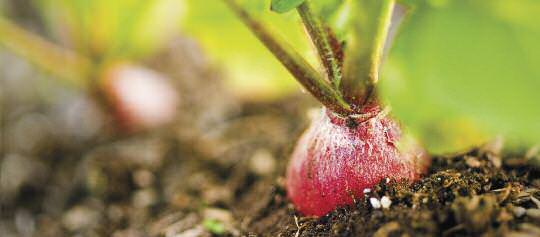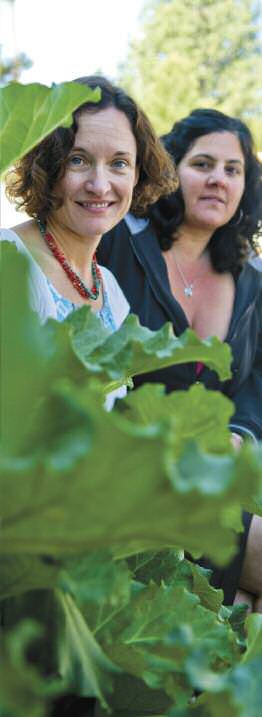community gardens
CULTIVATING WELLNESS
Project MANA manages community gardens and a lot more.
WRITTEN BY MARNIE MCARTHUR
PHOTOS BY CANDICE NYANDO
Nearly 50 million Americans experience what the government calls food insecurity. There is hunger in every county across the United States, according to a May 12, 2012 report on the CBS Nightly News. The mission of the hunger relief agency Project MANA (Making Adequate Nutrition Accessible) headquartered in Incline Village, is to reduce the incidence of hunger in North Lake Tahoe.
“We provide donated food from a variety of sources free to anyone in need, no questions asked,” says Heidi Allstead, executive director of Project MANA. “We have five food distributions a week on the north and west shores of Lake Tahoe and Truckee. In winter, we add two temporary distribution sites.”
| Stephanie Blume, Truckee program director for Project MANA, and Sue Morganti, garden manager for Project MANA, pose for a portrait in the Truckee Community Garden, which is located within the Truckee River Regional Park. |
The organization’s leaders also manage three community gardens, in Kings Beach, Incline Village, and Truckee. Volunteers harvest food, mainly from the Truckee garden, and learn sustainable, high-altitude gardening practices and techniques.
George LeBard, the former executive director of Project MANA, was strongly influenced by reading about a small monastery for gardeners in northern Scotland called Findhorn. He put his passion into practice as a Peace Corps volunteer in the early 1980s when he founded the Belize High School of Agriculture. When LeBard returned to Incline Village and Project MANA in 1998, he wrote the High Altitude Gardening Manual. In the forward he says, “We at Project MANA promote gardening for economic and nutritional value. With a little hard work and a little luck, you can do it.”
Stephanie Blume, Project MANA’s Truckee director, echoes this sentiment.
“People learn that no matter how small their yard is, they can create a garden bed and grow enough food for their families. Many of our clients have been successful,” she says.
Growing Nourishment
The first Project MANA community garden was established in Kings Beach in 1996 by two AmeriCorps/Vista volunteers, Sue Morganti and Sarah Zonka. Today AmeriCorps volunteers Deidre Ledford and Caitlin Jackson work from the Project MANA offices in the Donald W. Reynolds nonprofit center in Incline Village. Jackson coordinates volunteers while Ledford teaches nutrition in schools throughout North Lake Tahoe.
“We have a program in September where we bring preschool students to our demonstration garden on the Sierra Nevada College campus and have them pick vegetables, make a salad, and eat it together,” Jackson says.
In Kings Beach, a grant from the Tahoe Truckee Community Foundation funds the ongoing remodeling of an old motel property at Bear Street and Trout Avenue. The new community house is expected to open in 2013 with a new community garden, if space allows.
In the meantime, AmeriCorps volunteer Ledford hopes to get a gardening club started at the Boys and Girls Club.
“I’d like to have club kids work regularly with me in the original Kings Beach garden on Rainbow Avenue,” she says.
Truckee Space
The largest garden managed by Project MANA is located in Truckee River Regional Park between the children’s play structures and the Truckee River. It was developed in 2006 with support from the Truckee Donner Recreation and Park District.
“Momentum in the garden-to-table movement has renewed community interest and support,” Blume says. “A county grant in 2011 provided funds to hire a gardener, rebuild 16 raised beds, and add a work shed and overhead watering system. A 6-by-7-foot greenhouse cube was donated by Veggies Under Glass. We’re experimenting in the cube with tomatoes, cucumbers, and other temperature-sensitive crops.”
Two new projects in the Truckee garden are made possible by a $3,000 grant received in May 2012 from Patagonia. A recently completed gazebo will house children’s education programs. A children’s garden will feature small raised beds, including a digging beg for mud play, a root-view bed for seeing how veggies grow, and a fabric tree with colorful cloth strips to demonstrate wind action.
“Our goal is to make this garden more community oriented,” Blume says. “Residents will plant and maintain their own beds and be asked to donate some of their harvest to Project MANA’s distribution centers and for Hot Meal Thursdays, a program to assist the poorly sheltered.”
To better manage the increasing number of Project MANA activities, Sue Morganti recently returned to the organization as Truckee program coordinator.
“We’re very excited to have Sue on staff,” Blume says. “She brings a wealth of knowledge from her family farm in Willits, Calif. She’s eager to build community around the Truckee garden and to develop our Kings Beach garden over the next two summers.”

Volunteers are welcome in the gardens and to help with other programs. Find out more about Project MANA at www.Projectmana.org. To volunteer or to purchase copies of the High Altitude Gardening Manual, call 775-298-0008.
Freelance writer Marnie McArthur lives in a Reno condo, sadly without space for a vegetable garden. She satisfies her hunger for fresh veggies by shopping at farmers’ markets.


